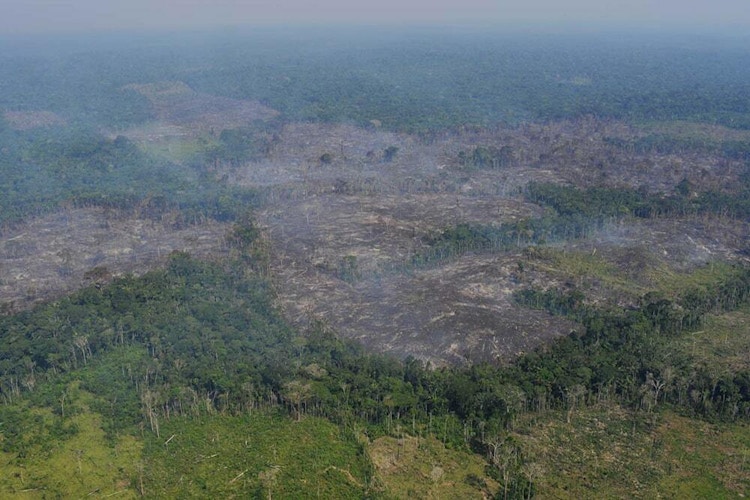Deforestation down sharply in Colombia in 2023
Deforestation in Colombia decreased by 70 % in the first nine months of 2023, compared with the same period last year. The situation remains fragile, with conflict and drought threatening to reverse the trend. Ongoing peace efforts include the environment as a crucial part of the peace process.

By Chris Lyngaas.
Colombia's Minister for the Environment, Susana Muhamad, announced the decline at a press conference in Colombia's capital Bogota earlier this month.
The figures confirm the downward trend in deforestation in Colombia. In 2022, deforestation decreased by 29% compared to 2021.
At the same time, the Minister for the Environment expressed concern that the ongoing drought in the Amazon could reverse the positive trend.
Colombia's new government, led by President Gustavo Petro, took power in 2022 and is committed to saving the rainforest. The government pays the local population to take care of the forest and has increased its efforts to combat environmental crime, measures that are now bearing fruit.
Conflict and violence hinder environmental work
Colombia is still mired in violence and conflict in many places despite the signing of the peace agreement with the FARC guerrillas in 2016. Limited government control makes efforts to protect rainforests and develop local communities challenging. The government is negotiating with a number of armed groups to bring peace and halt deforestation in areas these groups have taken control of.

DEFORESTATION: Deforestation in the Tinigua National Park in Colombia. The photo was taken during an overflight by the Colombian NGO FCDS, which monitors deforestation in the Colombian Amazon. Photo: FCDS
Peace and environmental work are closely linked
Rodrigo Botero is a member of the Colombian government's negotiating delegation with the ELN guerrillas, where he advises on rainforests in particular. He recently visited Norway to meet with Norwegian authorities and politicians, and to attend the tenth conference of the Colombia Forum, which Rainforest Foundation Norway chairs. He is clear on the fact that environmental and peace work in Colombia are closely linked.
"We cannot protect ecosystems and forests without including a peace component. In a peace process, we look at the victims, and the environment is a victim of the conflict in Colombia. There is a lot of deforestation and environmental destruction in the conflict areas. For the first time in the peace process in Colombia, the environment is not just part of the process, it is absolutely central. It starts with the recognition of the territorial rights of local communities and of the environment as a victim of the conflict," he says.

RODRIGO BOTERO: Rodrigo Botero at the "Together for Peace in Colombia" conference in Oslo, Norway on 24 November, 2023. Photo: Monica Orjuela.
FCDS and Rodrigo Botero
The Foundation for Conservation and Sustainable Development (FCDS) is a Colombian NGO that promotes peacebuilding through a territorial environmental management method that emphasizes environmental protection and sustainable development, focusing on the Colombian Amazon.
FCDS monitors deforestation in the Colombian Amazon through regular overflights. Both Rainforest Foundation Norway and authorities from Colombia and Norway have participated in such overflights to see deforestation with their own eyes. During the election campaign in Colombia last year, all the presidential candidates took part in overflights, and in March 2023, Norway's then Minister of Climate and Environment, Espen Barth Eide, did the same.
Following the peace agreement in 2016, Rainforest Foundation Norway has partnered and collaborated with FCDS, which also maintains a close dialogue with Norwegian authorities on peace and forests.
Rodrigo Botero is a recognised Colombian environmentalist and head of the FCDS. He is a member of the Colombian government's negotiating delegation with the ELN guerrillas, where he advises on rainforests in particular.
Still critical for the rainforest in Colombia
At the same time, there are strong counterforces at work, and the situation remains fragile. President Petro faces several challenges, including strengthening protected areas, keeping environmentalists and social leaders safe, combating environmental crime and limiting the massive loss of forest, including what is disappearing in national parks and indigenous reserves. Unfortunately, the country is also at the top of the world rankings when it comes to the murder of indigenous people and environmental defenders.
The ongoing drought in the Amazon may also help to reverse the promising environmental progress. The Colombian government has also expressed concern that a recent halt in peace talks between the Colombian government and the armed group Estado Mayor Central (EMC) could lead to an increase in deforestation. This is a critical time for the rainforest in Colombia.
"It is crucial that Norway now takes the opportunity and the historically close cooperation with Colombia to step up support for Colombia's efforts to save the rainforest and ensure a sustainable peace. This will create positive ripple effects far beyond Colombia's borders," says Toerris Jaeger, executive director of Rainforest Foundation Norway.

The Colombian Rainforest
The main threats to the rainforest in Colombia come from the cattle industry, mining, logging and agriculture, much of it illegal. Drug production also threatens rainforests, indigenous peoples and local communities in the country.
Much of the rainforest remained untouched as a result of 50 years of civil war between the state and the FARC guerrilla group, but after the FARC laid down their arms in 2016, these rainforests became available for industry and agriculture. Deforestation in Colombia increased sharply after 2016, decreasing slightly in 2019 before declining significantly in 2022.